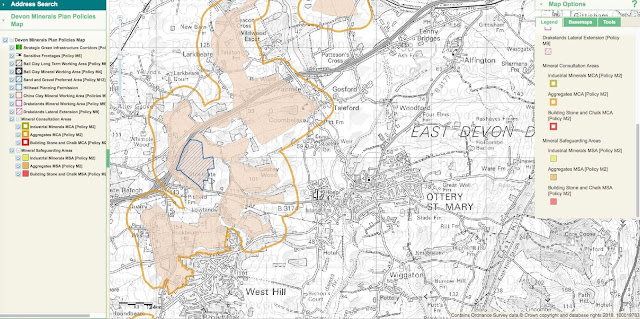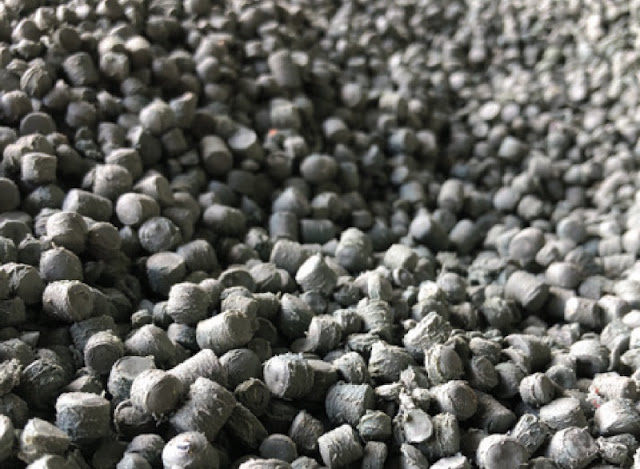Aggregate Industries on the other hand is not running complex underground Mongolian copper projects. It runs bog-standard open-cast sand and gravel quarries. Despite that, the company really does seem useless at working out how many tonnes of material it can wrestle from the ground at any one site.
Would a fortune-teller have more luck? Or is there something else going on? Does Aggregate Industries consistently overestimate the amount of mineral available at a new site – to exaggerate the 'benefit' that planners must weigh against a proposal’s environmental damage?
Last week,
we posted about Aggregate Industries’ application to extend Chard Junction Quarry in the Dorset AONB, but that wasn’t the only one the company lodged with Dorset Council for this site in 2020.
This planning application seeks permission to vary conditions 5 and 6 of planning permission number 1/D/12/000079 to vary the Phase 3 and 4 Working Plans together with the Restoration Plan and the associated Cross Section Plan of the development relating to the “Carter’s Close” working area at Chard Junction Quarry, Thorncombe, Chard, Dorset. 1.1.1
In May 2012, (the Applicant) received planning permission for the extraction of a further 1.5 million tonnes of sand and gravel as an extension to Chard Junction Quarry, Chard, Dorset. The permission extended the Hodge Ditch working area in an easterly direction towards Forde Abbey. 1.7.1
Phases 1 and 2 of the Carter’s Close working proposals are now complete. However, when entering into Phase 3 of mineral extraction, the sand and gravel reserves were found to be significantly shallower than anticipated and the Lower Lias Mudstone (clay) outcropped earlier. As a consequence, it was not possible to work the quarry as approved under drawing number 943/PL10A. The impact of the clay outcropping earlier continued into Phase 4 further reducing the volume of sand and gravel reserves and again, preventing the company from complying with drawing number 943/PL11A. Following further geological assessments, it was calculated that the impact of the clay outcropping earlier was a decrease in the reserves within the Carter’s Close working area of circa 300,000 saleable tonnes. 2.3.2
Gee. Two out of four phases. 300,000 saleable tonnes. That’s quite a mistake. A 20% mistake. That can be the difference between making a profit and making a loss.
How much does a mistake like that cost? If we assume a lowly £30/tonne, that’s lost sales of a not insignificant £9 million. In reality, the sum may be higher, given a 0.8 tonne bulk bag of 20mm Chard gravel retails for
£75 or more, and
Aggregate Industries claims there's:
strong demand for Chard gravel... mostly manifested in the sought after 20 mm single sized golden gravels decorative stone of which represented 50% (92,626 tonnes) of 2017 sales.
Whoops. Surely heads must have rolled.
But it’s not the first time this has happened. Aggregate Industries has something of a track record in this small region of the South West. In fact, the company has now significantly overestimated the resource figure in four local sand and gravel quarries:
At
Marshbroadmoor, the original planning application promised 1.1 million tonnes, but, due to 'geological faulting', no more than 200,000 tonnes ever came out.
At
Venn Ottery, an application to "vary conditions" also had to be made after the company reported "an error with the previous estimated amount" and revised reserves down by 1,200,000 tonnes, almost 50%.
At
Houndaller, a "re-evaluation of reserves" lost in the region of 700,000 tonnes.
And now Chard Junction. That’s a cumulative 3.1 million tonnes across just four relatively small sites.
You wonder if Aggregate Industries makes any money at all in this part of the world, given the size of those mistakes. Isn't it critical for any company who wants to make a profit from digging up stone to know how much material it can expect to find, so it can work out operating costs, margins, prices, etc?
Or are these re-evaluations par for the course? Are they already factored in?
In other words, when Aggregate Industries submits a planning application, does it not only underplay the environmental harm, but also overplay the 'benefit'? Did the company, for example, exaggerate the size of the 'benefit' available at Chard by 300,000 tonnes to help tip the planning 'balance' to win permission to work in the Dorset AONB – an area supposedly afforded the highest level of protection under planning policies? Is it doing the same again at the adjacent Westford Park Farm extension – also in the AONB?
There are parallels here with Straitgate Farm’s inclusion in the Devon Minerals Plan.
For the Chard Junction extension in 2011, Aggregate Industries' original application
claimed:
Geological modelling, quarry design and reserve assessment has proven 1,500,000 saleable tonnes of mineral exists at Carters’ Close. This is classified as Measured Mineral Resource according to the Pan European Reserves and Resources Reporting Standard 2008. 2.4.5
"Proven". It’s a strong word, and later shown to be wrong to the tune of 300,000 tonnes. In an attempt to add further credence, note the reference to PERC.
For anyone interested:
PERC is the organisation responsible for setting standards for public reporting of exploration results, mineral resources, and mineral reserves by companies listed on markets in Europe.
a saleable tonnage of 3,450,000 tonnes has been proven for the proposed phase one extraction area, and 3,795,000 tonnes has been proven for the proposed phase two extraction area.
Test drilling indicates up to 3.6 million tonnes. Lifetime of site approximately 10 years based on 350,000 tonnes per year.
Resources were re-calculated accordingly and currently amount to 1.2 million saleable tonnes. "Resources are classified as Measured Resource according to PERC Standard 2013". Calculations have been undertaken by Chartered Geologists. 1.4.6
Note that "proven" has gone, and the words "currently amount to" point to future re-evaluations, but at least references to PERC and "chartered geologists" have been added in an attempt to make the statement look authoritative.
Whether calculations are undertaken by chartered geologists or fortune-tellers, whether
proven or embossed with golden PERC standards, 1.2 million saleable tonnes is not available at Straitgate – as we’ve posted in
What ‘benefit’ is left for AI at Straitgate Farm?
Neither is Aggregate Industries – with forecasting estimates adrift by hundreds of thousands of tonnes, errors of 20% at Chard, 50% at Venn Ottery, 80% at Marshbroadmoor – correct with the
finger-in-the-air re-evaluation of Straitgate's resource – an impossibly precise "0.8% reduction" based on "a realistic assessment of the change in [maximum water table] arising from the readings in April 2018".
The proposed base will therefore have to be re-interpolated to include this figure, and lifted accordingly. Aggregate Industries has yet to say publicly how much further this will cut the available resource. All we know is that any guesstimate could of course be wrong by 20%, 50% or even 80%.
It is the diminished benefit, the diminished, unproven, questionable amount of sand and gravel at Straitgate that must be weighed against the very real destruction of an East Devon farm, the very real risk to drinking water supplies to more than a hundred people, to Grade I listed Cadhay and its gardens, the very real loss of ancient hedgerows and veteran trees, habitat for bats and dormice, and the very real damage to our climate from a 2.5 million-mile haulage scheme.
With Aggregate Industries' woeful track record at forecasting tonnes in the ground, how can anybody have any faith that the claimed benefit at Straitgate would turn out as advertised? Aggregate Industries' planning applications clearly have that fast-food tendency – to over-promise and under-deliver.













